Why Meteora Greece Is Worth Visiting in 2025
Are you planning your trip to Greece and wondering if it’s worth visiting Meteora? The answer is usually yes!
An often overlooked Greek gem which is also a UNESCO World Heritage status, Meteora is a uniquely spectacular rock column formation in Northwest Greece, with 6 Eastern Orthodox monasteries sitting atop these tall rock columns. Meteora offers both a fascinating geological formation and is the second most important religious site for the Eastern Orthodox Christians.
Moreover, Meteora is less than a 4 hour drive from Athens, very affordable compared to the islands and gives you the opportunity to witness a change of scenery in Greece.
How much time do you need in Meteora?
Ideally you need 2 nights stay with 1 full day to enjoy all that Meteora has to offer. That’s what I did on my trip and I found it to be the perfect amount of time.
If you have only a one week itinerary in Greece and plan to go to the islands (like Naxos, Paros, or Milos), then I’d say you can skip Meteora due to the travel time it takes to and from the islands (plus the 3.5 hours up to Meteora from Athens).
However, if you’re just in Athens for a week or have more than 1 week to explore Greece then I’d definitely recommend making the ~3.5 hour drive up to Meteora. Or if you have already explored the Greek Islands and are looking to check out mainland Greece, then Meteora should for sure be on your itinerary.
There are also daily tours that go from Athens to Meteora, which you could opt for if you want to do this in one day.
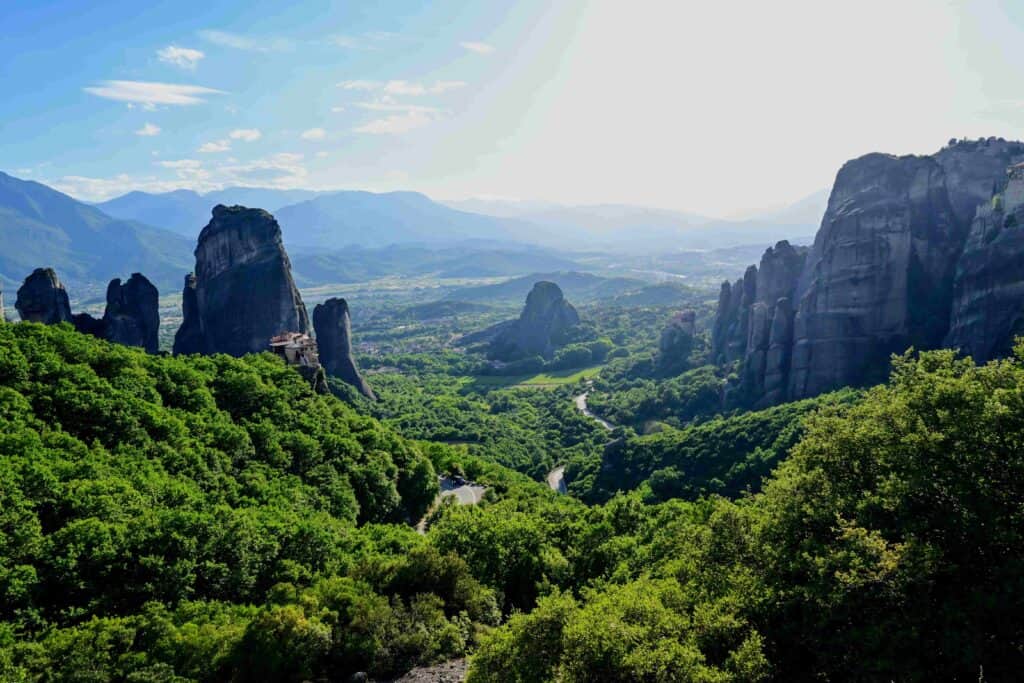
What To Do In Meteora
Here are the best things to do for your day or two in Meteora.
Visit the Meteora Monasteries
Through the 13th & 14th centuries, there were 24 monasteries that were established atop the towering rock columns of Meteora. Today, there are 6 that survive and are well worth visiting.
These are all active monasteries and can be accessed through the day for a EUR 3 ticket fee paid in cash. I’d recommend picking 2-3 monasteries to visit and accounting for 3-4 hours to visit them all.
You can’t really go wrong with the views but the Great Meteoron and the St. Stephen nunnery, at opposite ends of Meteora, will give you two complete views from either end of the 6 monasteries. There are also many viewpoints along the road that connect all the monasteries.
Keep in mind that each of the monasteries is closed to visitors during one day of the week in summer and up to 3 days in the winter. All of them are open on Saturdays and Sundays through the year. Also, each monastery has slightly different hours ranging from 9am – 3/4/5 pm with some closing an hour or two in the daytime for lunch so be sure to check the current schedule before making your plans!
5 of the 6 monasteries are accessible only via steep stairs. The St. Stephen nunnery which is at the end of the road that connects all the Meteora monasteries is the only one with an easy, flat path access to the entrance.
Parking is available at the monasteries. However, during peak tourist season, you may have to park on the road and do a bit of walking.
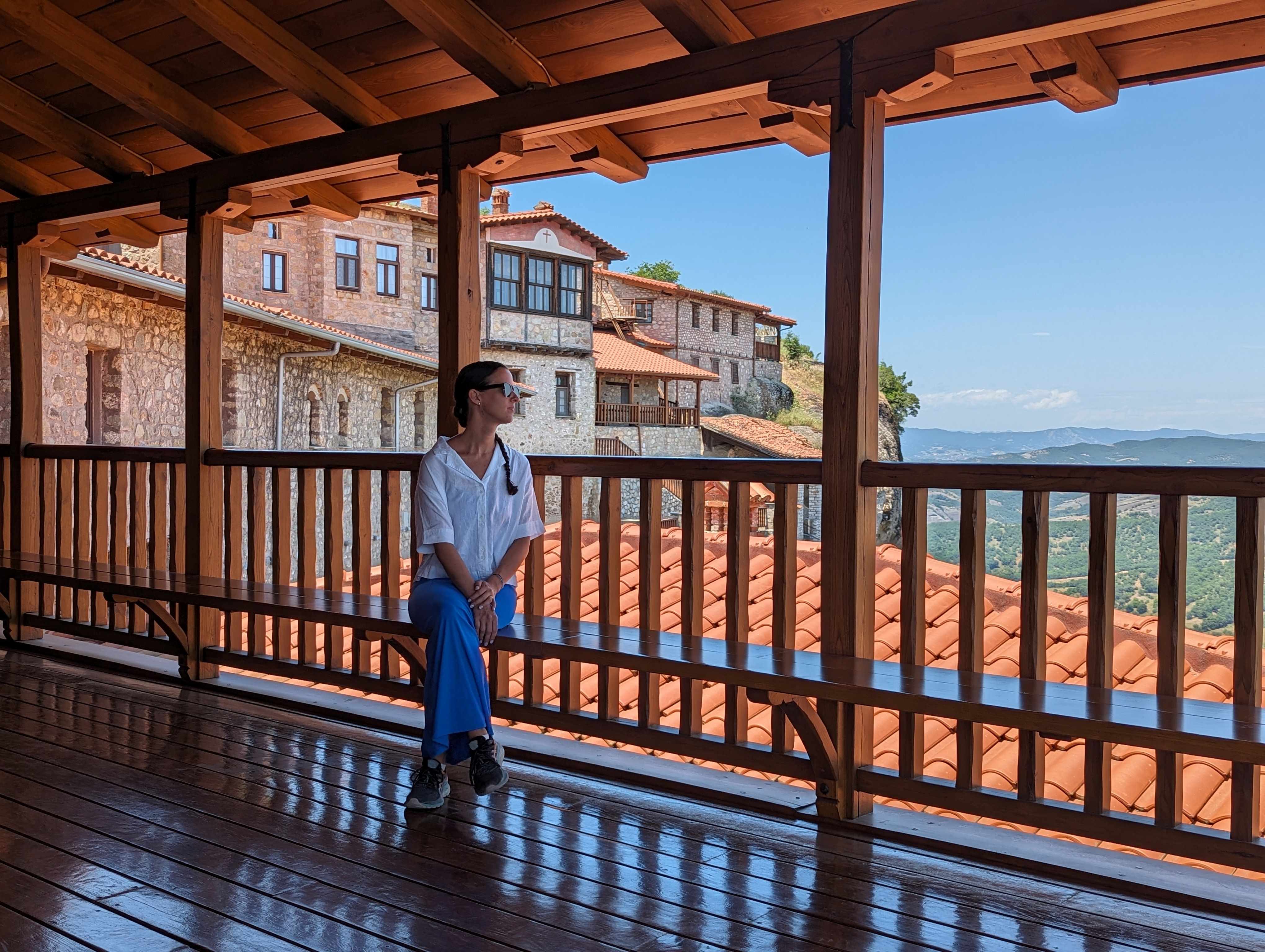
Watch the sunset
The Meteora sunset is legendary and something Greeks rave about. You will too once you’ve seen it! The Main Observation Deck of Meteora is the best place to watch the sun go down behind the towering column and monasteries. However, the spot often gets crowded and parking gets full, creating a bit of a commotion during sunset.
I’d recommend getting there an hour before sunset to find a nice spot. The changing light, colors and cloud formations along with the unique view will be well worth it! We were told that the sunset we saw wasn’t the best ever but we were absolutely enchanted!
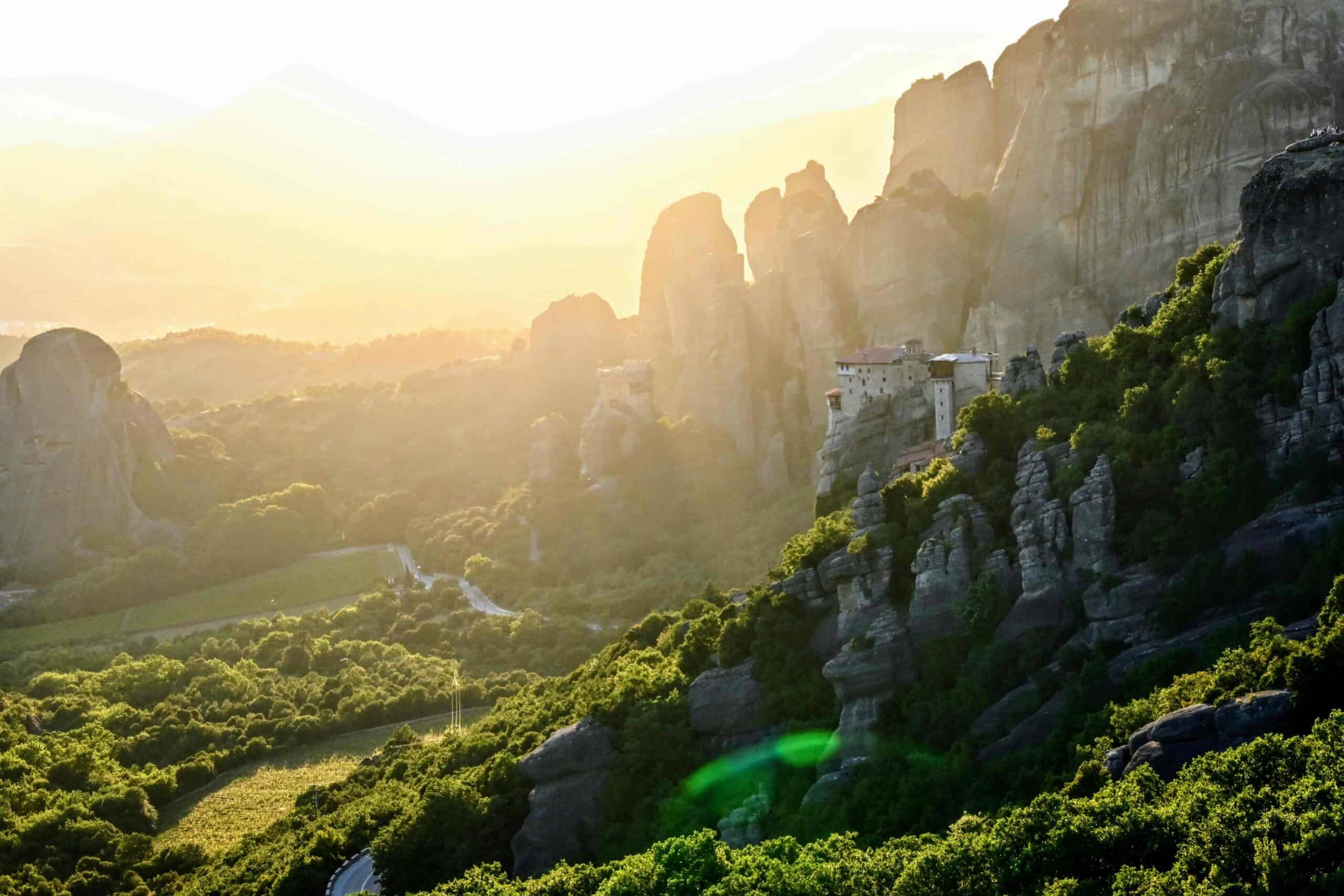
Marvel at the unique geology!
While Meteora is an important religious site, it is an absolutely unique geological marvel. Beside the Pindos Mountains, in the western region of Thessaly, Meteora’s rock towers were formed about 60 million years ago, rising steeply from the ground. Over millions of years, deposits of stone, sand and mud were accumulated here when streams flowed from the mountains to a large lake emptying into the sea, forming a delta.
Then, about 60 million years ago, a series of movements in the Earth’s crust pushed the seabed dramatically upwards, creating a high plateau and creating many vertical fault lines in the sandstone. Overtime, these sandstone pillars were sculpted by the forces of erosion – wind, rain and extreme temperatures.
While this type of rock formation has occurred in many places in the world, what makes Meteora unique is the uniformity of the sedimentary rock deposited, leaving few signs of any vertical layering.
Eat at a Greek Taverna
Both Kalabaka and Kastraki are littered with Tavernas run by local families. It is a tradition here, and in other parts of Greece, to be given free dessert after your meal. The friendly locals are also always up for a chat, even if their English may not be the best.
Moreover, you can also spend a leisurely afternoon, sitting on the sidewalk, looking up at the rocks and monasteries, sipping some wine, gouging on delicious food while seeing the sleepy towns go about their day. The souvlakis and moussakas are hearty favorites, and every taverna has their own little variations.
Our favorites were: Greek Tavern to Kalami and Boufidis Greek Taverna.
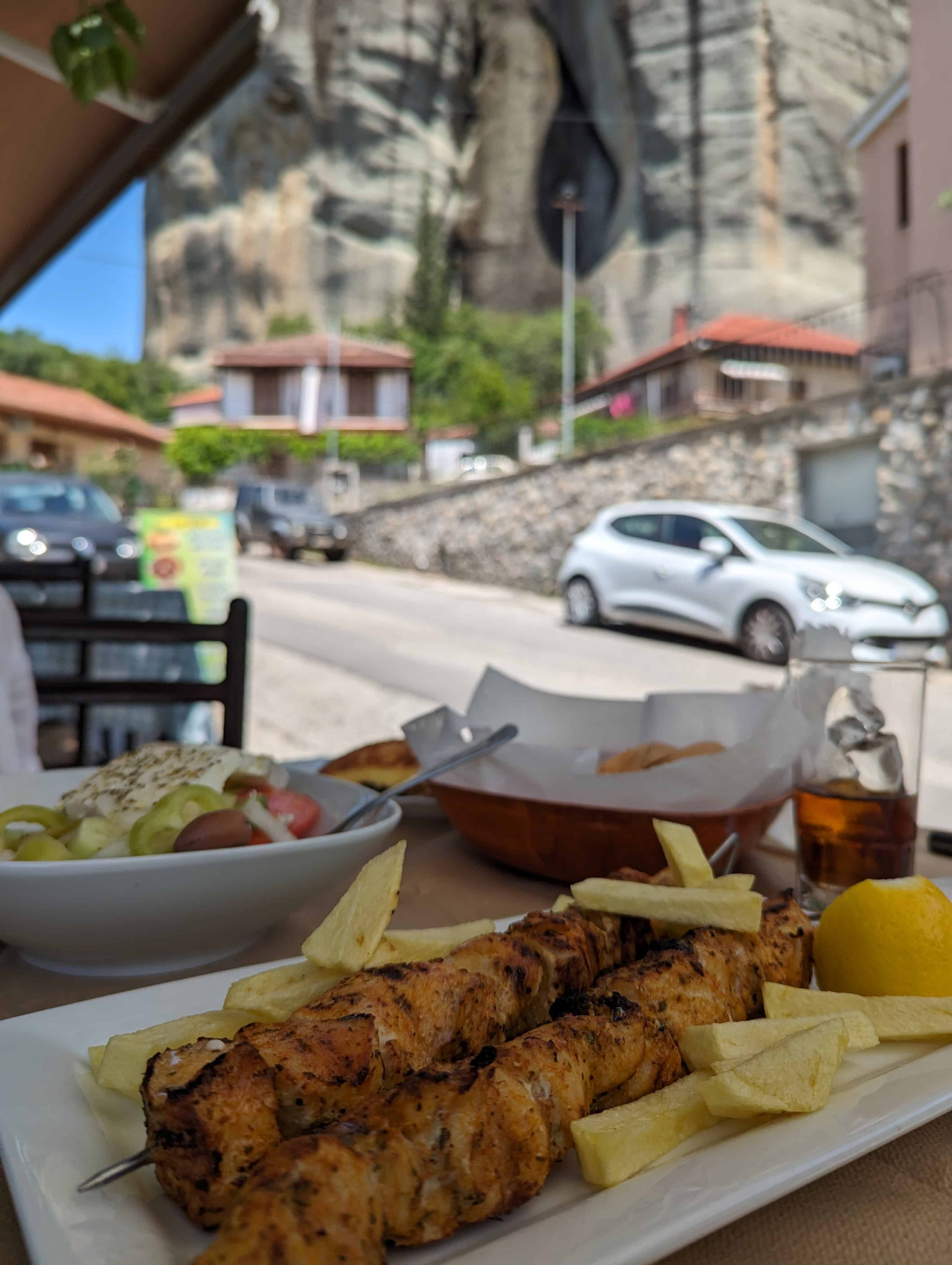
Go for a drive
Meteora rises spectacularly and can be witnessed from a few miles away, when driving towards it. The newly built expressway from Athens is an absolute pleasure to drive on and the drives around Meteora only get better.
I’d recommend doing the drive through Epar Od. Meteoron-Kallitheas which is the road that connects all the monasteries and loops around the towns of Kalabaka, which is the larger town and Kastraki, at the foot of the rock formations. The whole drive takes about 20-30 minutes and thus, it would be recommended to drive both ways to really take in the views.
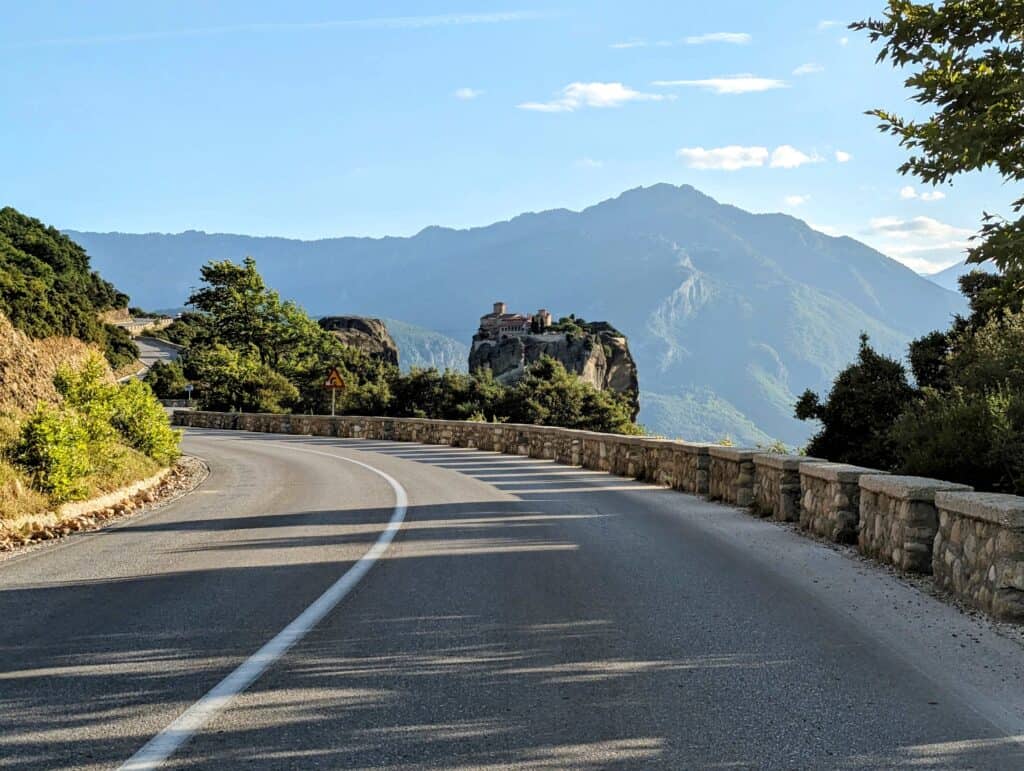
Explore the towns of Kalabaka and/or Kastraki
The sleepy towns of Kalabaka and Kastraki, offer a quaint escape from the hoards of tourists on the Greek islands. Both have a small, but beautiful old town, where you can enjoy a coffee, gelato, lunch or simply a stroll, white looking up at the gorgeous rock formations of Meteora.
What is the best time of year to visit Meteora?
While Meteora is a place you can visit through the year, the peak season is between July to October, which brings with it large numbers of tourists, like anywhere else in Greece.
While there will be less tourists than you find on the islands during the peak months, due to the tiny roads, parking spaces in Meteora, it gets quickly filled up. The peak months also coincide with the hottest days in Greece with temperatures reaching up to 40C or 104F with extremely hot afternoons.
The shoulder season which runs from November to May is a good time to visit, avoiding the crowds, extreme temperatures and enjoying off-season rates. May is especially ideal as the temperature is still cool, while the days are long enough to plan a whole day here.
What is so special about Meteora?
The unique mix of geology and religious sites makes Meteora a must see for any traveler, once in their lifetime. It gives you a unique mix of natural history, scenery, religion, food and local culture to experience in a place often overlooked by travelers to Greece.
How hard is it to walk Meteora?
Some monasteries in Meteora are tougher to access than others. The Great Meteoron monastery is the steepest while the St. Stephen Nunnery has the flattest, easiest access path. You can look at the path you need to take to get the monastery in most monasteries before you enter / pay for your ticket. So, you can easily gauge the difficulty of the stairs before embarking on the climb.
It took us about 10 minutes to get up to the Great Meteoron monastery using the stairs. It was crowded so you have to navigate waiting for others who may be slower on the steps.
You can also walk the road between the monasteries, with Great Meteoron and St. Stephen being about 4.2kms / 2.6 miles with stopping at viewpoints and monasteries along the way. If you’re there in the height of summer be prepared for heat as the sun beats down on you.
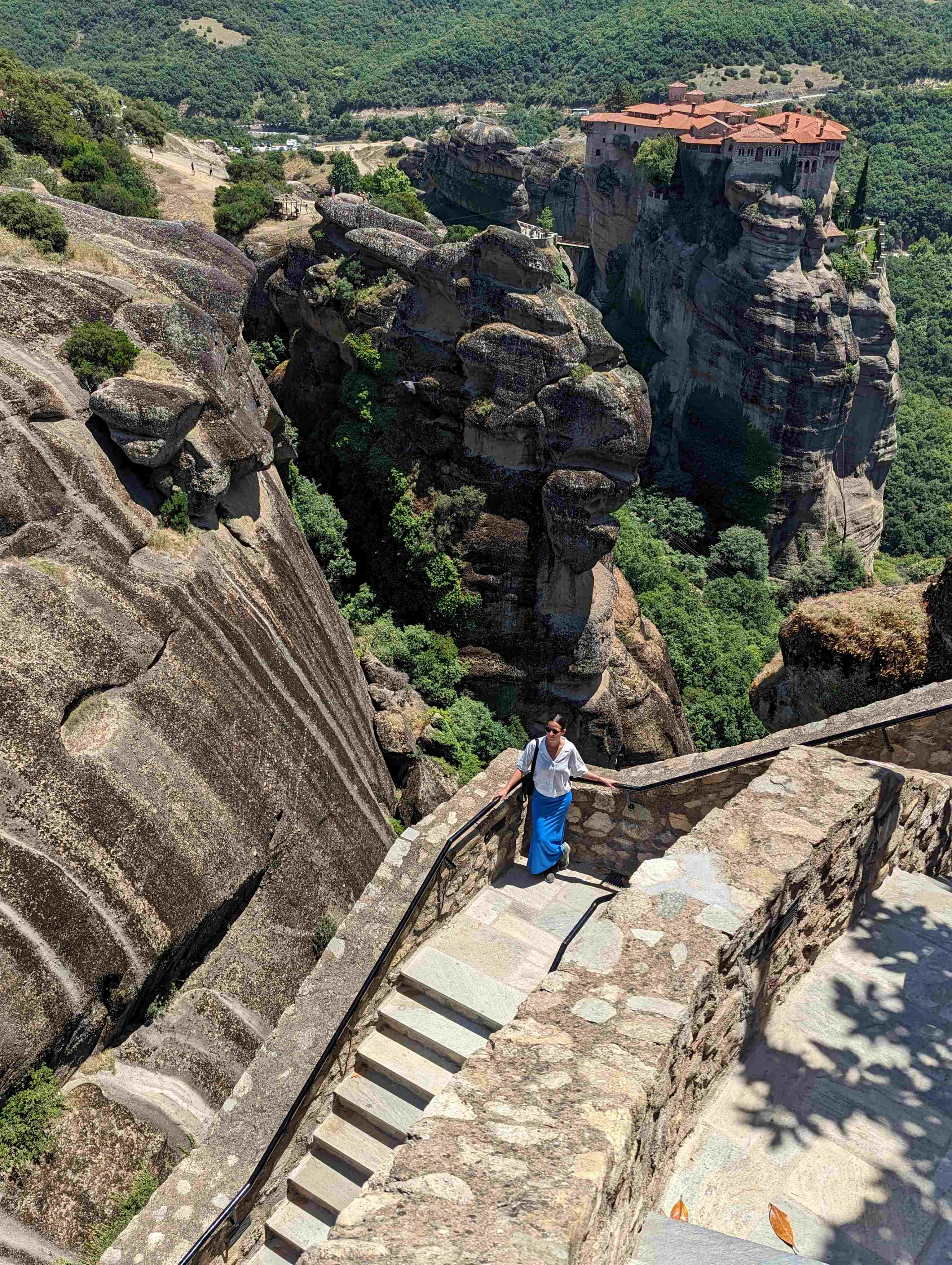
Can you visit Meteora without a tour?
Absolutely, you can visit Meteora without a tour! I recommend visiting on your own so that you have flexibility in travel plans, take your time at the monasteries, pick which ones you want to visit and stay as long as you want for that sunset you’ll remember for the rest of your life!
However, if you aren’t comfortable driving on your own, then a one day tour from Athens or Thessaloniki would be the most convenient way to get there. Some options include:
Best Athens to Meteora Day Trip Tours
➡️ Athens: Meteora Monasteries & Caves Day Trip & Lunch Option
➡️ Athens: Meteora Monasteries Tour with Greek Lunch Option
Best Thessaloniki to Meteora Day Trip Tour
➡️ Thessaloniki: Full-Day Bus Trip to Meteora
How To Get To Meteora
Distance from Athens: 344 kms / 213 miles
🚗 By Car: ~3h30m
Important note: Gas and tolls are expensive in Greece, especially on the expressways. We paid over 70 Euro during our round trip from Athens to Meteora to Phillipe and back to Athens. If you’re just going from Athens to Meteora and back, be prepared to pay about 40 Euro in tolls.
You can avoid tolls by taking the non-tolled one lane highways. However, add about 2 hours to your drive from Athens if you choose that option.
🚌 By Public Bus: ~5-6 hours
Buses to Meteora depart from Athens’ Liosion Bus Station (KTEL Liosion). You’ll take a bus to Trikala, which typically takes about 4.5 hours. From Trikala, transfer to a local bus to Kalambaka, the town at the base of Meteora, which takes an additional 30 minutes.
🚆 By Train: ~4-5 hours
Trains depart from Athens’ main railway station (Larissa Station). There are both direct trains to Kalambaka and options that require a transfer at Palaiofarsalos so pay attention to if your route requires a transfer. The train journey is scenic, passing through mountains and plains.
🎫 By Guided Tour: All day excursion lasting ~12-14 hours (including the bus ride there and back) that usually starts around 7:45am.
Where To Stay In Meteora
There are two towns at the base of Meteora that you can look for accommodation in.
Where to Stay In Kalabaka
Kalabaka is the larger of the two towns and serves as the main gateway to Meteora. The town has a range of accommodations and dining options. If you’re looking for supermarkets, pharmacies and souvenir shops – you’ll find them here.
Kalabaka is the transportation hub, with a train station and bus connections to other parts of Greece, including Athens and Thessaloniki. This makes it a good base for those relying on public transportation.
It’s also also home to a small but informative museum, the Natural History Museum of Meteora & Mushroom Museum.
📍Theatro Hotel Odysseon: The hotel’s name and decor are inspired by the world of theater, with rooms named after famous Greek plays and characters. Each room is designed with artistic touches, providing a one-of-a-kind stay. The hotel also features a lovely garden, perfect for relaxing after a day of exploring.
📍 Dellas Boutique Hotel: Located between Kalabaka and Kastraki. The hotel combines classic decor with modern amenities, offering a luxurious yet cozy atmosphere. The rooms are spacious and tastefully decorated, with many offering views of the Meteora rocks.
Where to Stay In Kastraki
Kastraki is a smaller, more traditional village located just a few minutes from Kalabaka. At the base of the Meteora rock formations, it’s ideal for those who want to start their exploration early or if you plan on hiking up to the monasteries.
While Kastraki doesn’t have as many accommodation options as Kalabaka, the ones it does have are charming and often family-run. You’ll find a range of guesthouses, boutique hotels, and bed-and-breakfasts.
📍Archontiko Mesohori Meteora: Stay here for an authentic Greek experience with a touch of luxury. This boutique hotel is a restored 19th-century mansion located in the heart of Kastraki village with some rooms featuring views of the Meteora rocks.
📍Guesthouse Vavitsas: A great budget option, this is where we booked fairly last minute and we had a pleasant 2 night stay here.
TL;DR: Why Meteora Greece Is Worth Visiting
Meteora is a unique geological formation, made even more interesting by the 13th, 14th century monasteries that were setup here and can still be visited. Moreover, it is easily accessible from Athens & Thessaloniki and is an overlooked gem on the Greece tourist itinerary.

